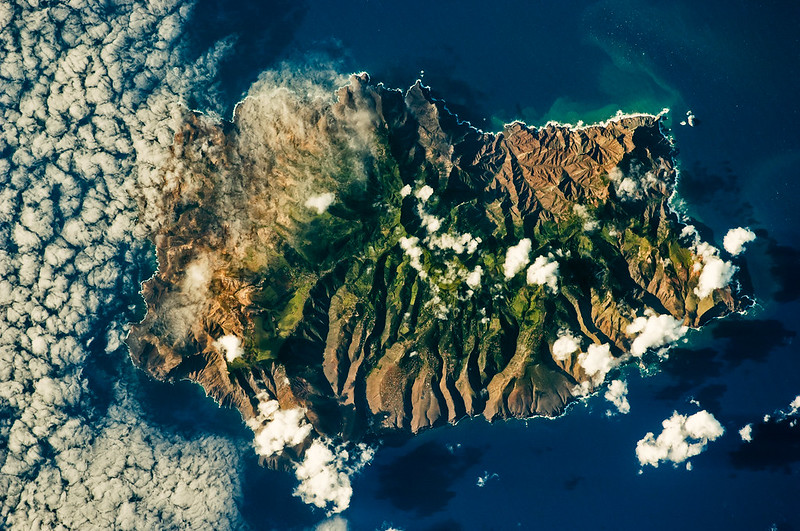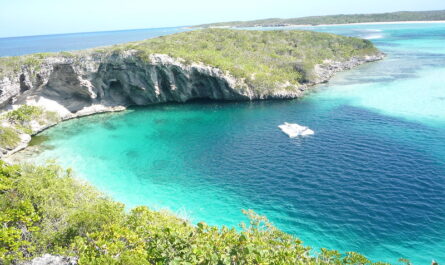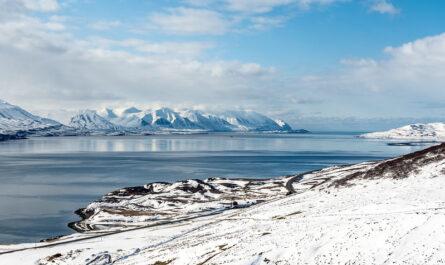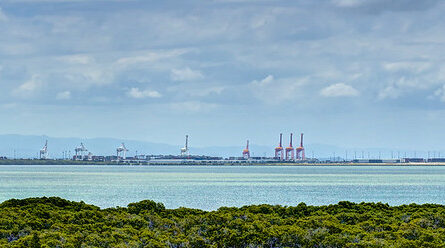Located more than 1,200 miles off the coast of southern Africa, in the middle of the South Atlantic Ocean, lies one of the most remote inhabited islands in the world—St. Helena. This small island, just 47 square miles in size, may be best known for its role in history as the final exile of Napoleon Bonaparte, but St. Helena is also home to a unique and thriving marine ecosystem that few places on Earth can rival.
From its rugged volcanic landscapes to its vibrant underwater habitats, St. Helena stands as a testament to the enduring beauty of untouched wilderness. Its remoteness has allowed both land and marine ecosystems to develop in relative isolation, resulting in a rich diversity of species, many of which are found nowhere else in the world. This article explores the fascinating blend of history and nature on St. Helena, diving into the island’s significance as Napoleon’s last home and its remarkable marine life that captivates conservationists and explorers alike.
St. Helena: A Glimpse into History
St. Helena was first discovered by Portuguese sailors in 1502, though it remained largely uninhabited until the British East India Company established a settlement in 1659. The island quickly became an important stopover for ships traveling between Europe, Africa, and Asia. Its remote location and natural fortifications made it a perfect strategic outpost, and St. Helena remained a British possession from the 17th century onwards.
However, St. Helena is perhaps most famously remembered for its association with Napoleon Bonaparte. After his defeat at the Battle of Waterloo in 1815, Napoleon was exiled to St. Helena by the British, who saw the island’s remoteness as a guarantee that he would not escape. Napoleon spent his final six years on the island, living in Longwood House—a modest residence located in the island’s interior—until his death in 1821. His tomb, nestled in a peaceful valley on the island, remains one of the most visited historical sites on St. Helena today.
For history buffs and adventurers alike, the island offers an intriguing glimpse into this chapter of European history. Napoleon’s exile adds a deep historical layer to the island’s appeal, but its isolation has also preserved something far older and more wondrous—the unique marine life that surrounds it.
The Isolation That Created St. Helena’s Unique Ecosystem
St. Helena’s geographic isolation is one of the defining factors that has shaped its ecosystem. The island is volcanic in origin, formed millions of years ago by the same tectonic forces that created other isolated Atlantic islands like Ascension and Tristan da Cunha. This separation from mainland continents has allowed the island’s flora and fauna to evolve in relative isolation, resulting in a high degree of endemism.
The surrounding waters of St. Helena are home to an astonishing variety of marine life, much of which is either unique to the island or rarely seen elsewhere. The underwater environment around St. Helena is characterized by steep drop-offs, volcanic rock formations, coral reefs, and deep-sea habitats that support a thriving biodiversity. This marine wilderness remains largely undisturbed by human activity, making it a haven for researchers, conservationists, and divers.
St. Helena’s Marine Life: A Hidden Gem
St. Helena’s marine environment is one of the richest and most pristine in the South Atlantic Ocean. Its waters host over 750 species of marine life, including 50 species that are found nowhere else on Earth. This remarkable diversity is partly due to the island’s location at the crossroads of tropical and temperate ocean currents, which bring a variety of nutrients to the surrounding waters and sustain a wide range of marine species.
Whale Sharks: The Gentle Giants of St. Helena
One of the most iconic marine inhabitants of St. Helena is the whale shark, the largest fish in the ocean. These gentle giants can grow up to 40 feet in length and are known for their slow-moving, filter-feeding behavior. St. Helena is one of the few places in the world where whale sharks can be reliably seen in large numbers, especially during the peak season from December to April.
Unlike many other whale shark habitats around the world, St. Helena offers an extraordinary opportunity for close interaction with these majestic creatures, as they swim near the surface and around the island’s coastal waters. The island has become a popular destination for eco-tourism, with diving and snorkeling tours offering once-in-a-lifetime experiences to swim alongside these awe-inspiring animals.
St. Helena is also an important site for whale shark research, with ongoing studies aimed at understanding their migratory patterns and behavior. Conservation efforts have been stepped up in recent years, with the island’s government working closely with international organizations to ensure the protection of this vulnerable species.
Endemic Marine Species: A World Apart
In addition to whale sharks, St. Helena’s marine environment is home to a variety of endemic species, many of which are adapted to the unique conditions of the island’s waters. One such species is the St. Helena Butterfly Fish (Chaetodon sanctaehelenae), which is found only in the waters surrounding the island. This brightly colored fish is a favorite among divers and underwater photographers, known for its striking patterns and social behavior.
Another notable endemic species is the St. Helena Wrasse (Thalassoma sanctaehelenae), a small, brightly colored fish that inhabits the island’s rocky reefs. These wrasses play an important role in maintaining the health of the reef ecosystem by feeding on algae and helping to keep the coral free from overgrowth.
St. Helena is also a sanctuary for endangered green sea turtles, which nest on the island’s beaches. These ancient reptiles, which have roamed the Earth’s oceans for millions of years, come ashore to lay their eggs during the nesting season, providing a rare and incredible sight for those lucky enough to witness it.
Coral Reefs and Volcanic Underwater Landscapes
The coral reefs surrounding St. Helena may not be as extensive as those found in tropical regions, but they are nonetheless vital ecosystems that support a wealth of marine life. The island’s reefs are characterized by a mixture of hard and soft corals, sponges, and algae, which provide shelter and food for fish, invertebrates, and other marine species.
Unlike the expansive coral systems of the Caribbean or the Indo-Pacific, St. Helena’s reefs are interspersed with volcanic rock formations and underwater caves, creating a dramatic and varied seascape. These volcanic features are remnants of the island’s fiery past, sculpted by millions of years of geological activity. Divers and snorkelers exploring St. Helena’s reefs are treated to a unique underwater experience, where coral gardens are punctuated by towering volcanic outcrops and dark caves teeming with life.
Dolphins, Humpback Whales, and Other Marine Mammals
The waters around St. Helena are also home to a number of marine mammals, including dolphins and humpback whales. Dolphins, particularly the pantropical spotted dolphin, are a common sight in the island’s coastal waters, where they can often be seen riding the bow waves of passing boats. These playful and intelligent creatures are a highlight for visitors, offering an unforgettable wildlife experience.
During the winter months, humpback whales migrate through the waters around St. Helena, where they can be seen breaching and slapping their tails as part of their dramatic mating displays. These whales travel thousands of miles from their feeding grounds in the Antarctic to the warmer waters of the South Atlantic, making St. Helena a key stopover in their migratory journey.
Conservation Efforts and Sustainable Eco-Tourism
St. Helena’s unique marine ecosystem is relatively untouched by the pressures of overfishing and industrial development, but that does not mean it is without threats. The island’s remoteness has acted as a natural barrier to some forms of human impact, but climate change, pollution, and the growing interest in tourism have brought new challenges.
The St. Helena government, in collaboration with international conservation organizations, has implemented several initiatives to protect its marine environment. In 2016, the island declared a 445,000-square-kilometer marine protected area (MPA) around its waters, one of the largest in the world. This MPA helps safeguard the island’s coral reefs, endemic species, and migratory marine mammals from harmful human activities such as overfishing, illegal poaching, and pollution.
Eco-tourism also plays a vital role in preserving St. Helena’s natural beauty while providing sustainable economic opportunities for the island’s small population. Local businesses have embraced eco-friendly tourism practices, offering responsible wildlife tours, diving excursions, and educational programs that promote marine conservation.
Conclusion: St. Helena’s Blend of History and Nature
St. Helena stands as a beacon of both historical significance and natural wonder. From its role as the final exile of one of history’s most famous figures, Napoleon Bonaparte, to its status as a marine biodiversity hotspot, the island’s unique blend of human and natural history offers an experience like no other.
The isolation that once made St. Helena a perfect prison for Napoleon has also allowed its ecosystems to flourish in a way that few places on Earth can match. Today, the island’s marine life, from whale sharks to endemic fish species, continues to thrive in an environment that remains largely untouched by human exploitation. St. Helena’s wilderness, both above and below the water, offers a glimpse into a world where history and nature intertwine, creating a legacy that stretches far beyond the shores of this remote Atlantic island.
As conservation efforts continue, and with sustainable eco-tourism on the rise, St. Helena’s marine life remains a shining example of what can be achieved when nature is allowed to thrive. Whether for its rich history or its unparalleled natural beauty, St. Helena is a destination that will captivate visitors and conservationists alike for years to come.



